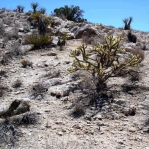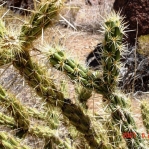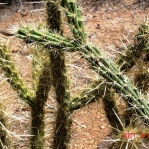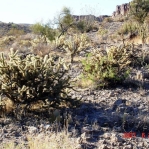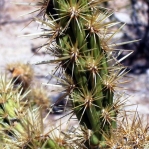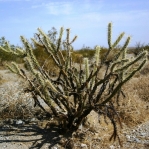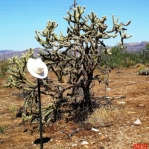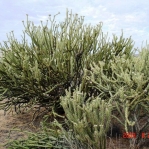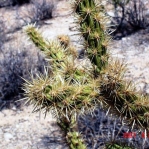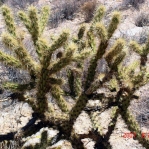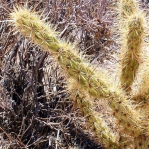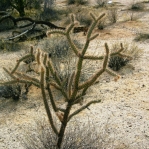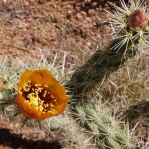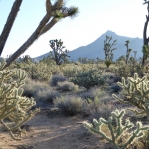G. Engelmann & J. M. Bigelow. 1856. Proceedings of the American Academy of Arts and Sciences 3: 308.
Herbarium specimen; Herbarium specimen; Herbarium specimen (G. acanthocarpa var. major); Herbarium specimen (G. acanthocarpa var. thornberi); Herbarium specimen (G. acanthocarpa var. thornberi); Herbarium specimen (G. ×congesta); Herbarium specimen (G. ×tetracantha); Herbarium specimen (G. acanthocarpa × G. spinosior)
Original species description
Flora of North America treatment
What is Cylindropuntia acanthocarpa?
Cylindropuntia acanthocarpa is a cholla that occurs in a wide variety of habitats in the Mojave and Sonoran deserts of southeastern California, southern Nevada, southwestern Utah, Arizona, and northern Mexico.
Details
The plants are shrubs to tree-like shrubs, growing up to 2 m tall and occasionally larger. The terminal stems are firmly attached and are 10 to 50 cm long by 2 to 3 cm wide with 6 to 20 yellow, tan, or red-brown spines, aging grey. The sheaths are white to grey with yellow tips. Flower color ranges from yellow to bronze to dark red. The filaments are dark red, and the styles range from light pink to dark red. The fruits are dry and sparsely to densely spiny.
Several varieties of Cylindropuntia acanthocarpa have been described, including G. a. var. thornberi, G. a. var. major, and G. a. var. coloradensis. However, recent multivariate analyses of morphological characteristics of the varieties have shown that G. a. var. coloradensis cannot be adequately separated from G. a. var. acanthocarpa (Baker & Cloud-Hughes, in press). This same study determined that G. a. var. major is an invalid name and that this variety should revert to its earlier valid designation of Cylindropuntia acanthocarpa var. ramosa. Much taxonomic confusion has been caused by Benson’s unnecessary designation of neotypes and lectotypes within this species in his attempt to validate G. a. var. coloradensis. The study by Baker and Cloud-Hughes attempts to clarify the taxonomy of this species and its varieties and will be made available here upon final publication.
Cylindropuntia acanthocarpa var. thornberi occurs in desert grasslands, chaparral transition zones, rocky hills, and ridges in central Arizona from 600 to 1500 m elevation. It is distinguished by long tubercles (2.5 to 4.5 cm), 6 to 11 spines per areole, which do not or barely interlace with the spines of adjacent areoles, and fruit with few spines.
Cylindropuntia acanthocarpa var. major (ramosa) occurs in sandy flats, washes, and rocky slopes at 300 to 900 m elevation from central Arizona to northern Sonora, Mexico. It is distinguished by having 14 to 18 yellow to red-brown spines per areole and by having narrower stems and thinner spines than the other two varieties.
All varieties of Cylindropuntia acanthocarpa are diploid (2n = 22).
Cylindropuntia acanthocarpa hybridizes with G. bigelovii (G. ×campii), G. whipplei (G. ×congesta), G. echinocarpa (G. ×deserta), and G. leptocaulis (G. ×tetracantha). It has also been known to hybridize with G. abyssi, G. multigeniculata, G. spinosior, and G. versicolor.
